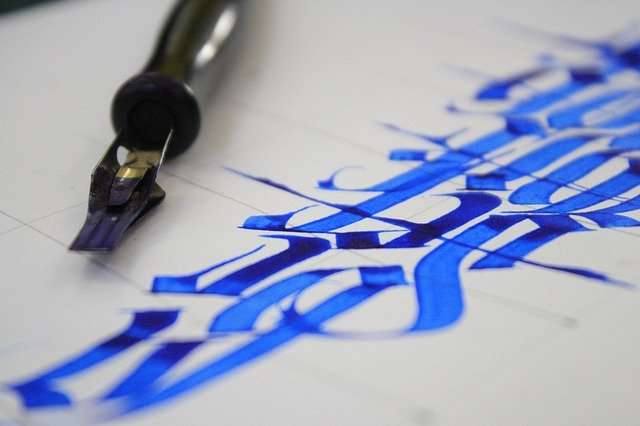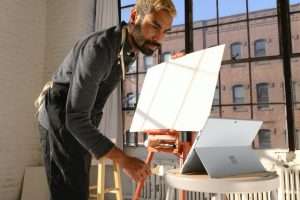In the following discourse I will attempt to show you how to set up your own home studio for portrait photography. The cost of setting up a home studio is minimal when compared to the equipment needed in a professional setting.
Setting up a home studio is an excellent way to increase the quality of your photographs at a lower cost than purchasing expensive commercial studio equipment.
Home studio equipment includes available light, a backdrop, portability and versatility, and modifiers like umbrellas, softboxes, and grids.
Here then is a list of possible equipment for your home studio:
Available light – This is by far the easiest setup. Window light or very bright overcast days are best. For window light you need nothing more than the window itself with white curtains; this will provide soft diffused light that is perfect for product shots or headshots. Using window light as your main source of lighting in a portrait situation can be tricky however, as it usually means dealing with harsh shadows caused by the sun streaming in through the windows.
For overcast days you will need an area outside that receives direct sunlight and some way to diffuse that sunlight so that it isn’t too harsh. A white sheet hung from above can provide enough diffusion to eliminate hard shadows and soften the light quite a bit
After a while, you might find that your home studio becomes more than just a place to take pictures. It can also be a great place to relax with friends and family. If you have the space and budget, we encourage you to give it a shot. With the right equipment, you can be making amazing portraits in no time!
Home studios can benefit everyone from amateur hobbyists to established professionals. You don’t need to rent an expensive studio or carry tons of equipment around with you. Even having a table top studio setup at home can give you quality results. It’s all about creativity and experimentation, so try new things and see what happens!
Practice makes perfect, so don’t be afraid to get started today! Here’s a list of equipment that we’ve used for our home studio:
Tripod – You may already own one or two tripods from taking pictures outside or from your phone. These can come in handy for shooting indoors as well. A tripod will help keep your camera steady throughout the exposure which will help reduce blurriness in your images. This is especially important when using long shutter speeds such as 1/8, 1/4, 1/2 or even longer, but will really help with any type of photography where you would
A studio, or home studio, can be a very useful tool for a photographer to have. It is a place where you can test and tweak your lighting techniques and get the results you want with little-to-no cost. Most importantly, it is a place where you can work on your craft without having to worry about what people are doing in the background.
I will go over some equipment which I have found helpful in creating a studio at home. I will also list some helpful software that I use in editing my photos and creating my own backgrounds.
Software:
Photoshop CS2 is the program I use to edit all of my photos. I would recommend getting an extended license because it costs less than $100 and includes extra features such as Adobe Camera Raw, which allows you to do many things with your photos that aren’t available in other programs. If you don’t want to spend extra money on an extended license, it won’t hurt anything if you just use the program for free for 30 days. I would highly recommend it though because it’s probably one of the best photo editing programs out there.*”
The footprint of a studio can be small, with only a couple of light stands and strobes to control the ambient and main lights. These are the most basic requirements for any portrait session and can be easily setup in your home or garage.
Tripod:
A tripod is a must-have for any photographer. Camera shake can not only ruin a photo but also cause blurriness and distortion. A sturdy tripod will allow you to keep your camera still during long exposures, or when using a slow shutter speed which is useful when photographing children and pets. Tripods are also useful when you need to have both of your hands free during a shoot such as an engagement session or even a newborn shoot. Tripods come in low, mid-level, and high-level with prices ranging from $50 to $200 however the best tripods are usually priced between $100-$200 because they are much more sturdy than cheaper models.
Cable Release:
Another important item for any photographer’s bag is a cable release. A cable release device allows you to lock the shutter open so that you can leave your camera in one position while you go about setting up lights or moving subjects around. You can also use it to take photos without shaking the camera at all giving
If you are reading this, you have already realized that shooting at home is more convenient than traveling to a photo studio. Why? Because you do not have to travel and search for a parking spot. The distance between your home and the place of the photo shoot is zero. Besides, you will have full control over the whole process of shooting by yourself. Finally, you can avoid unnecessary expenses on an external service.
But there are certain drawbacks as well. Firstly, you should be ready to put a lot of effort into every single shot and make it perfect yourself. Secondly, although there are many different ideas of interior design in modern homes, most of them are not very suitable for taking photos. In addition, if you want to shoot without additional light sources or natural light only, it is better not to place your photo set in the kitchen or another brightly lit room. A darker room is better for those purposes.
\\\\\\\
So what should you include in your home studio? You will need an object (a mannequin), a background and a reflector board with two reflectors to be placed on each side of the object (the mannequin). This will allow you to achieve even lighting on all sides of the object and give more volume to it
The first thing you need to do is to find a room that can be used as your home studio. It should be a place where you can shoot freely without worrying about disturbance or noise, and also a place where you can leave your equipment and props set up. For example, if you are shooting in the dining room, you will want to move the table out of the way when it’s not being used.
TIP: If you have the room, consider setting up an area where you can shoot on the floor. This gives more flexibility for different angles and it also gives more options for lighting.
Studio lights, by their nature, are very hot and intense unless modified. Therefore, it is a good idea to have a room that has some kind of window blinds/curtains/shades to control the amount of natural light that comes into the room.
When choosing a location, remember that you will be working with background colors (usually black) and using large lights that may get quite hot. You want to choose a place where those things won’t create problems or cause damage. For example; leaving a light on while no one is around could create a fire hazard if there is too much flammable material nearby that might catch fire when
You can have a professional home photography studio by setting up a room to separate you and your subject. These rooms are commonly used by artists and photographers as they provide a specific environment which enhances the quality of your photographs and offers you control over the shooting conditions.
Telling someone that you want to be a photographer can be scary if you don’t know what to expect or how to get started in the business. However, by reading this article and having an understanding of how to set up a home photography studio, you can make the transition from enthusiast to professional.


